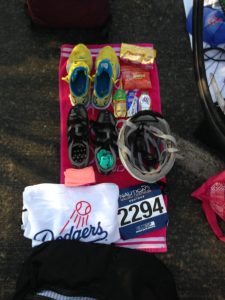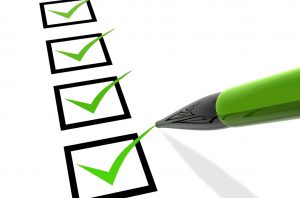Von Collins is an accomplished triathlete and endurance cyclist, and the author of four fitness and training books: Smarter Running, Your First Triathlon Guide, Fit Foods, and 30 Rut-Busting Workouts. He has been cited as a triathlon, cycling, and fitness expert by Healthline, CNET, Forbes, Eat This, Not That and other major outlets.
It is the night before your triathlon, and you know that you need to be on the road by 5:30am. Now is the time to get your stuff together, your car loaded, and be ready for a quick escape once you wake up in the morning. Let’s talk about what needs to be on your list so you can sleep with the peace of mind of knowing you have everything covered.

The triathlon race-day list is not as simple as “include this” and “don’t include that” because it can be different for each racer. How serious are you about the sport? Do you want to finish, or win? What are the conditions, and does that affect what you need to bring?
We separated the race day checklist into two sections: Must-have, and nice-to-have. Note that this is more geared to a Sprint, Olympic, and perhaps HIM distance. For those doing an Ironman race, you will want to think about several other things to bring. And let’s be honest, if you are doing an Ironman, you are way ahead of us on this.
Must Have: This list is for pretty much every skill level. These are the things that, if you don’t include them, might make it hard for you to actually do the race.
Nice-to-Have: This list is a little more geared toward people who want to get the most out of the sport, but someone who is either Spartan or a newbie might not view all of these items as essential.
The Must-Have Triathlon List:
- Wear your triathlon clothing and shoes. For many, we simply recommend wearing your tri shorts and your tri top or shirt to the race. You will also wear your running shoes and socks (if you use socks). Your running shoes will preferably have speed laces, if you have trained with them, but remember nothing new on race day. Keep in mind you will likely get a shirt at the race. This is nice to change in to after you are done racing.
- Bike. This might seem obvious, but people have forgotten bikes before. We recommend giving it a very brief, 1-block test ride the night before to make sure there are no surprises — a loose seat stem or leaky bike tire can be fixed before you get to the race.. Pump your tires up to the desired pressure before you leave home. If you want more info on triathlon bikes, we did an entire piece on them.
- Bike Carrier. If you can’t throw your bike in the back of your SUV or the box of your truck, you probably use a bike rack or carrier to transport it. Be sure that you can find it, and have all the parts ready to go for race-day morning. More than one race morning has been made frantic by the inability to locate a small part needed for the rack to function properly.
- Bike Shoes. If you use clipped or SPD bike shoes on the bike, don’t forget them. Along with helmets, this might be the most common thing to forget at home.

Bikes shoes might be the single most forgotten, and critical, race-day item.them. If you don’t use special shoes, you are fine. - Swim Goggles. We recommend a brand new pair. Using new swim goggles in your race will help reduce the glare if the sun is out. But be sure to buy a model you have used before, and test them out before the race.
- Wetsuit, if needed. If you are using a wetsuit for your tri, don’t forget it. If you will be racing in a wetsuit, just be sure you have used it before race day. Wetsuits are not required for most races (and if the water is too warm, they might not be allowed).
- Bike helmet. Any race using that USAT rules (which is most of them) require you to wear a bike helmet on the ride. It is not optional…. and it is smart.
- Sunglasses. For safety, you want to have shades on the ride to protect your eyes form bugs or debris, even if it is not a sunny day. Keep the sunglasses inside your bike helmet so you remember to put them on during T1. You want cycling glasses, preferably not just regular old sunglasses.
- ID. Some races require an ID at check-in. To be safe, make sure you have yours along.
- Water / Hydration. Always have some water. You never know how long you will be waiting for your heat to begin, and you do not want to be dehydrated. If you trained with gatorade or another sport drink, bring that as well.
- Nutrition. This is race and racer-specific, but we always like to carry some cliff bars and bananas in our bag, just to be safe (ideally, something you have already used during your training). Maybe you like gel shots, make sure you bring a few. We are also becoming big fans of sport drink powders and capsules that mix with your water, to create a sport-specific drink. We’re not telling you what to eat in this article, we’re just saying don’t forget it.
- Your race packet, if check-in was the day before the race. If you are to check-in on the race morning, disregard this one.
- Phone. Don’t forget your cell phone. It is the 21st century. You can leave it locked in your car during the race, although most transition areas are generally pretty safe places. It can be nice to have in your bag for camera access. If there is a chance of rain, put it in a ziplock bag. Besides, you probably need it for directions to the race, anyway.
- Race Address or Directions. Probably less important in the age of smart phones, but a good idea to have the exact location of the race.
- Transition Bag. By this point, you have probably figured out that all this stuff should go in a bag. While some buy specific triathlon transition bags for the sport, others, simply clear out their gym bag and use that. It is all a matter of budget and priority.
- Spare Tube, CO2, and Tire Changing Supplies. Some people feel that if they get a flat on the bike course, they will just walk back or drop out of the race. Not us! We think you should carry whatever supplies you would carry on a normal ride. Get a flat? Fix it, lose a few minutes, and keep riding! You don’t need to bring your entire gear kit, just what you would bring along on a good training ride.
Nice-to-Have Triathlon List

- Towel. Many racers like to have towels handy to dry off after the swim – primarily to help dry the feet. Some like a towel with a bright color as it can serve as an easy-to-spot marker for your transition spot. Towels can have an added benefit of giving you something to drape around yourself if you want to change before or after the race.
- Sport Guard, or similar product. This is a roll-on product that helps prevent chafing. Such products are usually advertised at “anti-chafe” cream or roll-on. Sport guard can be critical in longer races, but also helps your wetsuit come off easier if you apply it to your ankles before the swim.
- Bug Spray. In some races, bugs or water-borne gnats can be an issue, causing Swimmers Itch. Good idea to have some bug spray as it will keep them away.
- Sunscreen. If you will still be racing after about 10am, it is a good idea to apply some sunscreen, especially to the head and neck. Be sure it is waterproof so it doesn’t all come off during the swim.
- Bike tire pump. While some races have a bike tire pump for public use, we like to have one in the car just in case of surprises. Plus, it is nice to use the pump that you are familiar with, especially on race day. We just keep it in our car and pump the tires as soon as we arrive at the race, before we put our bike in the transition area. Remember to always check your tires, even if you pumped them the day before.
- Bike wrench. Good idea to have some basic bike repair equipment along. Again, this does not go on the ride with you, but is there for pre-race adjustments. If you forget, don’t fret — at many races there are staff from a local bike or tri shop to help with last-minute adjustments. Make sure your pedals, aerobars, and those all important cleats are nice and tight — but not so tight you break something!
- 2nd pair of socks. You never know if the first pair gets soaking wet for some reason.
- GPS Watch. Many triathletes choose to use a watch made specifically for triathlons. It can be worn during all three legs of the race. If you use a GPS watch like a Garmin watch that is not suited for swimming, have it ready in your Transition 1 so you do not spend frustrating minutes calibrating while you are going full-speed. If you rely on your Fitbit for key pacing information, don’t forget it either.
- Plastic bags. Some old grocery store plastic bags are awfully nice in the event it is raining on your gear while you swim. It will keep stuff dry until you put it on. It doesn’t hurt to leave your phone in one too, if there is a threat of rain in the transition area while you are out racing.
- Race Belt. You can simply pin your number on to your shirt (nearly all races provide pins) but a race belt it a much smoother way to do it….. and they are really inexpensive. In some races, the belt comes as part of the swag bag.
- Visor or hat…. If you use one. They can be nice during the run on a sunny morning.
- Outerwear. For fall or rainy-day races, bring the right gear to keep you dry and warm before or after the race.
- Change of Clothes. While it is often fine just to wear your race clothes all day, many will want a change of clothes with them. You might also want long-sleeved gear with you if the race is on a colder morning, gear you would then remove before the race.
- Sandals. Some racers prefer sandals to wear before the race, as they might want to have their shoes setup in the transition area, and walking in dew-filled grass might make the shoes damp prior to the race.
- If you rely on a daily medication, make sure you take it. You just might be starting your drive at 5am or earlier, so you could overlook this. The excitement of a race day can throw off routines, and we want to make sure you don’t skip an important med.
We did not include things that seem to be pretty random and personal preference. At each race, you will see people who brought stuff that we don’t deem essential — balloons to tie on to your transition spot (for easy location spotting), a water bucket to clean off your feet, etc. But if you noticed anything that we left off the list above, we’d love to hear about it. Maybe you will persuade us to include it!
![]()
Bike Once-Over on Race Day
We also recommend doing a once-over inspection of your bike the day or evening before the race. This will help you make sure there are no major surprises when you arrive at the venue on race morning. Be sure the moving components (wheels, chainrings, chain) are all moving freely and as designed. Check your bars and saddle to be sure they are secured and not about to loosen up. Things can move while in transit, whether on a bike rack or crammed in the back of your SUV with other gear. Give the bike a quick lube using some simple bike oil, just so everything is on its best behavior. But bon’t overdo it — you certainly do not want to be making actual fit adjustments right before a race — but you do want to be sure that everything is assembled and tightened as designed. Save the big fixes for after the race.
We prefer to wait until race morning to do a final tire pump-up. They can lose enough air overnight so you will want to top the tires off right before the race, anyway.
After all of that, the only other major tasks is to get some sleep. Easier said that done!








First tri I left towel in car by accident. When I came out of cold lake water I said to myself I’ll just dry off in the wind during the bike ride. Oh man was I frozen during that part!!!
I would recommend removing mirrors from the drop down bars on the bike and making sure that the handle ends are either capped or tapped.
No one mentioned is there a easy way to put on wet socks maybe there is a secret
We suggest a quick foot wipe-off with a beach towel. Having your socks a little wet is OK.
add baby powder to your socks. just coat the inside of the sock. it will absorb the moisture and make it easy to get them on wet feet even after you wipe your feet with a towel.
Put talc powder in your socks – just a little. They’ll slide on and dry really quickly
Love this tip!
Put the socks on first before the race, then roll them down towards the toe. Set them in your shoes ready for when you need them. Now during the race you can just pop your toe in and roll them up into place. I find it so easy when my feet are wet or damp.
Love this!